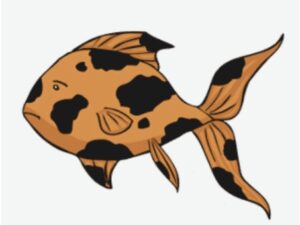Many fish are suitable for Nano tanks, but some are more suited than others. Small size is the most common feature shared by all of the fishes listed below.
However, even within this group of nano fish, there is huge variability in terms of what each type will need to thrive and maintain good health.
This article offers a brief summary of the common requirements and characteristics of 19 nano fish species that are suitable for nano tanks. This information should help you make an informed decision about whether or not to add one of these fishes to your aquarium.
Table of Contents
- Here’s a list of The Best Nano Fishes For Your Tank
- 1. Betta Fish
- 2. Guppy Fish
- 3. Platies
- 4. Cherry Barbs
- 5. Harlequin Rasboras
- 6. Neon Tetra
- 7. Cardinal Tetra
- 8. Zebra Danio
- 9. Kuhli loach
- 10. Bolivian Ram
- 11. Neon Blue Rasbora
- 12. Pygmy Corydoras
- 13. Dwarf Gourami
- 14. White Cloud Mountain Minnow
- 15. Killifish
- 16. Pencilfish
- 17. Rasbora
- 18. Tetra
- 19. Ram (Mikrogeophagus ramirezi)
- Conclusion
Here’s a list of The Best Nano Fishes For Your Tank
So here is the information of the best nano fishes which you must keep in your tank so that your tank looks wonderful.
1. Betta Fish
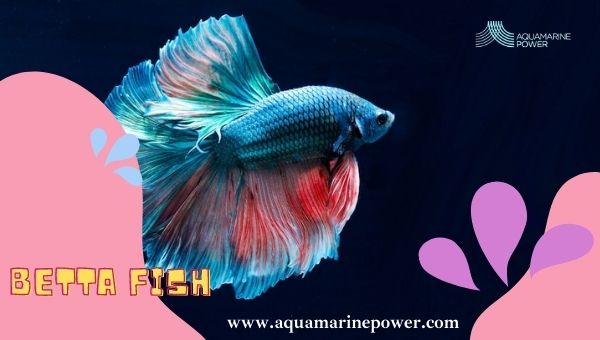
- Scientific Name: Betta splendens
- Size: 2 inches
- Lifespan: 1-2 years
- Nature: Semi-aggressive, especially to its own kind
- Water Temperature: 75 degrees Fahrenheit or above
- ph level: 6.5–7.5
- Required Tank Size: 1 gallon per fish (though 5 gallons is preferred)
- Required Water Type: Betta fish can thrive in either hard or soft water but should not be kept in alkaline water.
Betta fish are among the most popular fish for aquariums, and it’s easy to see why. They’re beautiful fish with vibrant colors and long, flowing fins. However, they must be kept alone because their very aggressive nature makes them territorial toward other bettas.
Male bettas can also become rather aggressive toward females during mating season.
Betta fish are not demanding when it comes to water temperature, but they prefer warmer waters (75 degrees Fahrenheit or above). When it comes to pH levels, bettas can live in either hard or soft water, but their long fins will become tattered if the pH is too high.
A 5-gallon aquarium tank is preferable for this type of fish, though it will still thrive in a smaller aquarium. The tank should be heavily planted on all sides to provide hiding places. Bettas can breathe air, so the water does not need to be aerated like some other types of fish, but additional oxygen can be provided by adding an air stone.
Bettas require a steady diet of insect larvae and worms, so feed with live or frozen food at least twice weekly. They can also be fed prepared betta pellets.
The water temperature should be around 75 degrees Fahrenheit, though bettas can survive in slightly cooler or warmer water as well.
The pH level should fall somewhere between 6.5 and 7.5, but still within the tolerable range for bettas is to 5-8.5. Bettas are often kept in hard or soft water, but they should not be kept in alkaline water.
They are also very sensitive to the presence of nitrates and ammonia, so keeping good care of them is essential.
Bettas can eat both pellets and live foods like brine shrimp or bloodworms, though this is by no means necessary. This allows bettas to be kept in very small tanks, especially when they are given supplemental foods.
2. Guppy Fish
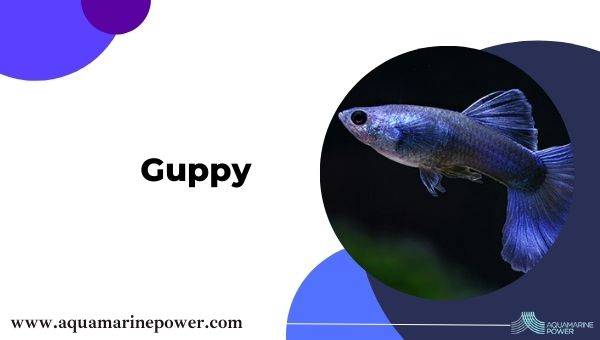
- Scientific Name: Poecilia reticulata
- Size: 1-2 inches
- Lifespan: 2–3 years
- Nature: Semi-aggressive, especially to its own kind
- Water Temperature: 75 degrees Fahrenheit or above
- ph level: 6.5–7.5
- Required Tank Size: 10 gallons per fish (though 20 gallons is preferred)
- Required Water Type: Guppies thrive in hard or soft water but should not be kept in alkaline water.
Guppies are classic aquarium fish that have been popular for decades.
They’re beautiful with vibrant colors, and their fins will grow quite long if they aren’t kept with other guppies of their own kind. Guppies can be kept in either a freshwater or brackish aquarium, though they thrive in harder water if given the option.
This type of fish prefers water temperatures of 75 degrees Fahrenheit or above. They can live in slightly lower or higher temperatures, but these levels are preferred within an ideal range.
The water pH should fall between 6.5 and 7.5, though once again, they can tolerate a more acidic range on either side.
Guppies do not require a large tank, but they do need a lot of plants. Most live plants will survive in their aquarium, though some may go into hiding or die off. Guppies prefer heavily planted aquariums with plenty of covers for them to hide under.
Guppies are omnivorous fish that require both animal and plant matter in their diets, so feed them a balanced diet of prepared fish food and live or frozen brine shrimp or bloodworms at least twice weekly.
Guppies are usually fairly peaceful toward other fish, but this may not apply when breeding season is upon them. Males will become more aggressive, so it’s best to keep only one male per tank.
To avoid cross-breeding, as few as three females could be kept with a single male as long as they have sufficient hiding places.
Guppies should be kept in groups of at least five or more to help them feel comfortable and safe. A 20-gallon aquarium can support a group of five guppies quite well, but larger aquariums are preferable.
Guppies can be kept in either a freshwater or brackish aquarium, though they tend to do better if given the option of slightly harder water.
In terms of tank decorations, female guppies enjoy heavily planted tanks with many hiding places. Males may fight over territory if too much space is available, so it’s best to keep only one male per tank if possible.
3. Platies
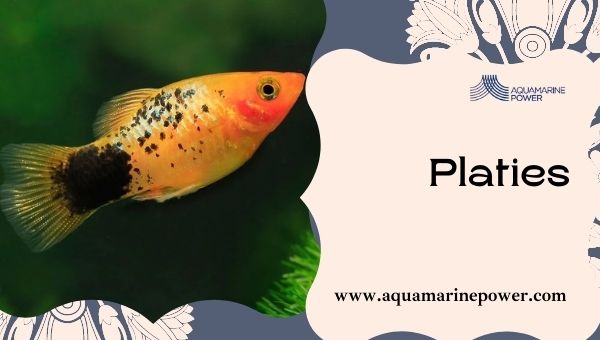
- Scientific Name: Xiphophorus maculatus
- Size: 2-3 inches
- Lifespan: 2-5 years
- Nature: Peaceful, schooling fish that works well with other tank mates. Males are territorial toward each other, so at least 10 gallons is required per male platy, or the males will fight.
- Water Temperature: 65-82 degrees Fahrenheit
- ph level: 6.0-8.5
- Required Tank Size: More than 10 gallons required, 20+ recommended
- Required Water Type: Soft water with medium to high oxygen flow. Platies are extremely sensitive to poor water conditions. Frequent partial water changes must be performed, and a good filtration system is required.
Platies are commonly found in pet stores, and they’re one of the few colorful fish species that aren’t bettas. They’re easy to care for as long as proper tank conditions are maintained.
Platies can be kept in community tanks with other non-aggressive fish, but they are quite timid and shouldn’t be kept with larger or more aggressive tank mates.
Place platies in tanks that are at least 10 gallons, as males can become aggressive toward each other if there isn’t enough room for the male to establish its own territory.
Male Platies tend to show their bright colors for a day or two after being purchased, and then their coloring fades away into a plain silver and black color.
Females and males both sport the same colorations of white (or very light yellow) bellies, black bodies with gray or silver accents, and orange/red spots on their anal fins. The orange/red coloration in the anal fin changes when they are ready to mate, and it brightens in color.
Platies also have a bright horizontal line above their eyes (though this is usually a little hard to see) that runs from their gill covers up to the mid-section of their body, starting at the bottom of their gill covers and ending just below the mid-section of their body.
There are several varieties of platies available, including black, albino, gold, purple, and white variations. Some varieties must be kept in tanks all by themselves as they are very aggressive toward other platies of their own kind.
Platies are sensitive to water conditions, but they are very hardy once placed in proper care. They enjoy swimming around the tank at all times of the day, which makes them perfect for any community type of tank set.
The only exception is if the male platy has established its own territory, in which case it will chase other tank mates away.
Platies are omnivores and shouldn’t be kept on a strict diet of protein-rich foods. They need plenty of algae and plant matter to eat so that they stay healthy, but they also enjoy eating blood worms or other types of fish foods.
4. Cherry Barbs
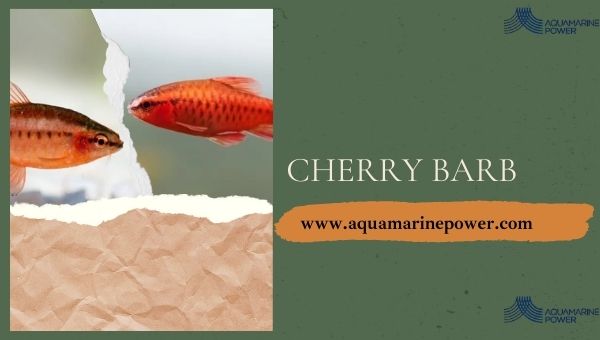
- Scientific Name: Puntius titteya
- Size: 2.5 inches
- Lifespan: 3-4 years
- Nature: Peaceful, schooling fish that works well with other tank mates
- Water Temperature: 65-82 degrees Fahrenheit
- ph level: 6.0-8.5
- Required Tank Size: A tank of at least 10 gallons is required for one pair; 20+ gallons is recommended for a community tank.
- Water Type: Soft water with medium to high oxygen flow. Cherry barbs are extremely sensitive to poor water conditions. Frequent partial water changes must be performed, and a good filtration system is required.
Cherry barbs are somewhat difficult to fish to care for, but their coloring makes up for it. Cherry barbs are small freshwater fish with red and orange blotches on their bodies that give them a “cherry” like appearance. They’re easy to care for as long as proper tank conditions are maintained.
Place cherry barbs in tanks that are at least 10 gallons, as they can become aggressive toward each other if there isn’t enough room for the male to establish its own territory.
Males should not be kept together as they will fight constantly, and females should never be kept together either as they will constantly fight as well.
Cherry barbs are sensitive to water conditions, but they are very hardy once placed in proper care. They enjoy swimming around the tank at all times of the day, which makes them perfect for any community type of tank set.
The only exception is if the male cherry barb has established its own territory, in which case it will chase other tank mates.
Male cherry barbs tend to show their bright colors for a day or two after being purchased, and then their coloring fades away into a plain silver and black color.
Females and males both sport the same colorations of white (or very light yellow) bellies, black bodies with gray or silver accents, and orange/red spots on their anal fins.
Cherry barbs are omnivores and shouldn’t be kept on a strict diet of protein-rich foods. They need plenty of algae and plant matter to eat so that they stay healthy, but they also enjoy eating blood worms or other types of fish foods.
5. Harlequin Rasboras
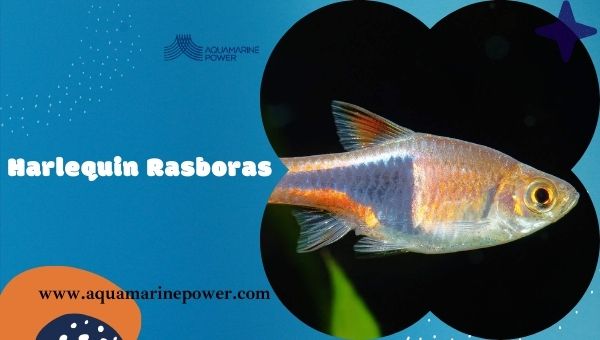
- Scientific Name: Trigonostigma heteromorpha
- Size: 1 inch
- Lifespan: 2-3 years
- Nature: Peaceful, schooling fish that works well with other tank mates
- Water Temperature: 76-82 degrees Fahrenheit
- ph level: 6.5-7.0
- Required Tank Size: 2 gallons is the minimum tank size required for this type of fish
- Water Type: Soft water with medium to high oxygen flow. The water temperature should be kept in the range of 76-82 degrees Fahrenheit. The ideal pH levels are between 6.5 and 7.0. They can live in either freshwater or slightly brackish water conditions.
Harlequin rasboras are a large group of fish consisting of more than 20 individual species, all in the Trigonostigma genus.
All of these fish have similar requirements for care and can be kept together in peaceful groups without issue, so it’s common for people to have them without knowing if they’re keeping the “right” type of fish.
Harlequin rasboras are peaceful, smaller-sized fish that should be kept in groups that consist of at least 3 individuals. Larger schools consist of 6 or more and maybe even better suited in a tall tank instead of a wide one.
They are known for being very active fish, often seen darting around the tank at all hours of the day.
They will not bother any other fish that they share space with because they are too small to pose a threat to other tank mates but should only be kept with peaceful tank mates due to their non-aggressive nature.
Harlequin rasboras are omnivores, and they should be fed a mixture of plant-based foods and protein. They are known to eat tubifex worms, bloodworms, or brine shrimp which can be used as occasional treats that you feed them in addition to their staple food.
Harlequin rasboras will eat almost any type of fish food, but their diet should consist mainly of protein-rich foods such as bloodworms and brine shrimp so they can maintain their energy and optimum health.
They also enjoy algae and plant matter, just like cherry barbs, so it’s best to include both types of foods in their diet.
Harlequin rasboras can be kept in tanks that are 2 gallons or larger, but the bigger the tank is, the better. They do best if kept in groups of 6 or more individuals because they are very active fish who enjoy being surrounded by other members of their species at all times of the day.
6. Neon Tetra
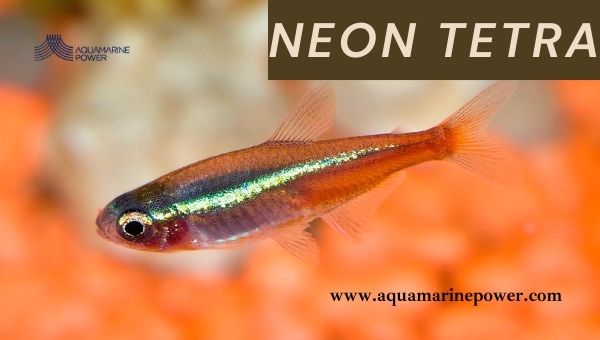
- Scientific Name: Paracheirodon innesi
- Size: 1 inch
- pH of water: 5.0-7.0
- Lifespan: 2-4 years
- Temperament: Peaceful, schooling fish that works well with other tank mates
- Water Temperature: 72-78 degrees Fahrenheit
- Water Type: Soft to medium-hard water with neutral pH levels.
- Minimum Tank Size: 10 gallons is recommended for new fish owners and people who want to keep a small school of Tetras
- Water Temperature: 72-82 degrees Fahrenheit
- Other requirements: Tetras are often labeled as freshwater fish, but they can live in slightly brackish water if it’s kept under 1.002 specific gravity.
Neon tetras are one of the most popular and well-known fish in the freshwater fish hobby. They’re easy to care for, active, brightly colored, and able to accommodate any freshwater aquarium that can meet their basic needs.
Neon tetras prefer water that is slightly warmer than their relatives but still in the mid-70s at most. Neon tetras are peaceful, active fish that prefer being kept in groups of 6 or more. They’re one of the easiest freshwater fish to care for because their needs only include a small tank and a steady diet.
Neon tetras should be fed flakes, frozen brine shrimp, and blood worms as part of their diet. They will eat most types of fish food, but they should avoid foods that are high in protein because it can mess with their digestive system and eventually cause internal infection.
Neon tetras are some of the easiest freshwater fish to care for. They make an excellent choice for beginner saltwater aquarists or even experienced hobbyists who want to try something new.
Tetras are often labeled as freshwater fish, but they can live in slightly brackish water if it’s kept under a specific gravity of 1.002. They also prefer a pH of 5.0-7.0 and a temperature range of 72-82 degrees Fahrenheit.
These fish are very active and love to dart around the aquarium as soon as the lights go on, so it’s important that they don’t outnumber their tank mates, or else they’ll bully them constantly.
These fish should only be kept with non-aggressive tank mates who can tolerate the same water conditions, and they also enjoy being kept in groups of 5 or more for their own peace of mind.
Neon tetras are omnivores but should only be fed high-quality flake or pellet food daily to ensure optimum health. They also like algae and plant matter, just like harlequin rasboras.
Neon tetras can be housed in tanks that are 2 gallons or larger, but the bigger the tank is, the better. They do best if they’re kept in groups of 5 or more so they can keep each other entertained and active throughout the day.
Recommended Food For Tetra
- TROPICAL FORMULATION: Highly digestible flake blend for use as staple food for...
- PLUS SHRIMP: With natural shrimp for maximum flavor – a natural attractant for...
- FOR ALL TROPICAL FISH: ProCare blend helps support your fish’s immune system...
- CLEAR-WATER FORMULA: Won’t cloud water when used as directed.
7. Cardinal Tetra
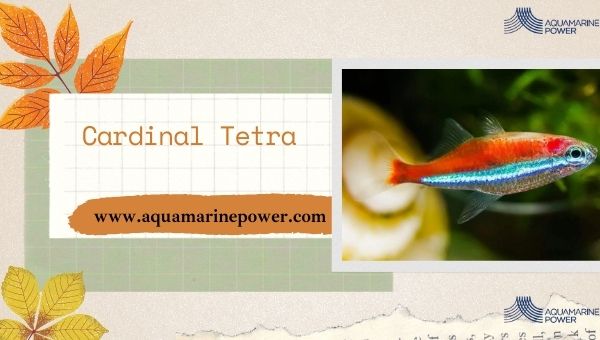
- Scientific Name: Paracheirodon axelrodi
- Size: 1 inch
- pH of water: 6.0-7.5
- Lifespan: 3-4 years if properly cared for
- Temperament: Peaceful, schooling fish that works well with other tank mates
- Water Temperature: 72-78 degrees Fahrenheit
- Water Type: Soft to medium-hard water with alkaline pH levels.
- Minimum Tank Size: 10 gallons is recommended for new fish owners and people who want to keep a small school of Tetras
- Other requirements: Tetras are often labeled as freshwater fish, but they can live in slightly brackish water if it’s kept under 1.002 specific gravity.
Cardinal tetras are some of the most brightly colored freshwater fish there is, and their brilliant red and dazzling black stripes and fins make them stand out in any aquarium.
These fish are schooling fish, and they should be kept in groups of at least 6 to reduce stress.
They can also be kept with other non-aggressive freshwater fish and freshwater catfish that prefer the same water conditions, but it’s important to remember that they will need more room than most other small aquarium fish because they grow fairly large.
Cardinal tetras have a peaceful and active demeanor, and they’re very easy to care for as long as their water parameters stay stable. They can adapt to a wide range of pH levels, but they won’t show off their best colors if their water is too acidic or alkaline.
Cardinal tetras should be kept in groups of at least 6, so they feel comfortable in their surroundings. They’re very active fish who are always on the go, so they need lots of room to swim around freely, or else they’ll become stressed out and sickly.
They’re very active fish who love to swim all around an aquarium, so it’s important that they don’t outnumber their tank mates, or else they’ll bully them constantly.
These fish should only be kept with non-aggressive tank mates who can tolerate the same water conditions, and they also like to be kept in groups of 5 or more for their own peace of mind.
Cardinal tetras are omnivores but should only be fed high-quality flake or pellet food daily to ensure optimum health. They also like algae and plant matter, just like harlequin rasboras.
Cardinal tetras can be housed in tanks that are 2 gallons or larger, but the bigger the tank is, the better. They do best if they’re kept in groups of 5 or more so they can keep each other entertained and active throughout the day.
8. Zebra Danio
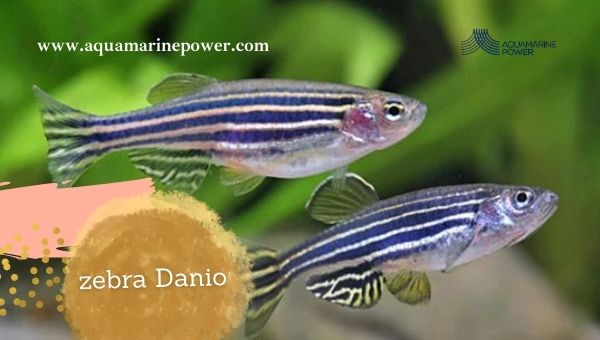
- Scientific Name: Brachydanio rerio
- Size: 2-3 inches
- pH of water: 6.0-7.5
- Lifespan: 3 years if properly cared for
- Temperament: Peaceful, schooling fish that works well with other tank mates
- Water Temperature: 68-82 degrees Fahrenheit
- Water Type: Soft to the slightly hard water with neutral pH levels.
- Minimum Tank Size: 10 gallons is recommended for new fish owners and people who want to keep a small group of Tetras
- Other requirements: The minimum tank size should be 20 gallons or more, and these fish will not do well in overly warm water.
Zebra danios are some of the most popular freshwater fish available because they’re so easy to care for and fun to watch. These fish were initially known as “zebrafish” but changed their name because they’re not in any way related to carp fish.
They’re very peaceful fish that can be kept with other non-aggressive tank mates, but they should only be housed with other fish who prefer to stay on the bottom of the aquarium because zebra danios are constantly on the move.
These fish are schooling fish, so they need plenty of their own kind to feel comfortable, and you’ll have much happier fish if you have the chance to keep them in a larger group.
They’re best kept with 3 or more of their own kind, but tanks with a minimum size of 20 gallons will make it a lot easier to accommodate them.
Zebra danios prefer soft and slightly hard water, and they can live in both freshwater and slightly brackish water.
They can adapt to a wide range of water conditions, but they’ll be most comfortable in warmer tank temperatures between 68-82 degrees Fahrenheit.
Zebra danios are omnivores but should only be fed high-quality flake or pellet food daily to ensure optimum health. They also like algae and plant matter, just like harlequin rasboras.
Zebra danios can be housed in tanks that are 2 gallons or larger, but the bigger the tank is, the better. They do best if they’re kept in groups of 5 or more so they can keep each other entertained and active throughout the day.
Also Read: The 11 Most Popular Pond Fish: Must Buy
9. Kuhli loach
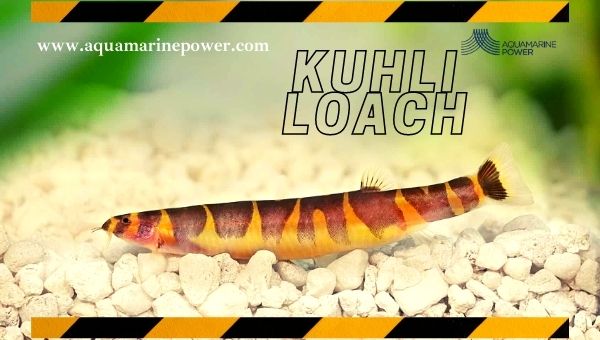
- Scientific Name: Pangio kuhlii
- Size: 2-3 inches
- pH of water: 6.5-7.5
- Lifespan: 5 years or longer if properly cared for
- Temperament: Peaceful, schooling fish that works well with other tank mates
- Water Temperature: 68-82 degrees Fahrenheit
- Water Type: Soft to the slightly hard water with neutral pH levels.
- Minimum Tank Size: 10 gallons is recommended for new fish owners and people who want to keep a small group of Tetras
- Other requirements: The minimum tank size should be 20 gallons or more, and these fish will not do well in overly warm water.
Kuhli loaches are some of the most peaceful freshwater fish available because they get along with other species very well. These fish were initially grouped into the same family as snakeheads but have since been reclassified into a different family after further inspection.
These fish are schooling fish, so they need plenty of their own kind to feel comfortable, and you’ll have much happier fish if you have the chance to keep them in a larger group.
They’re best kept with 3 or more of their own kind, but tanks with a minimum size of 20 gallons will make it a lot easier to accommodate them.
Kuhli loaches prefer soft and slightly hard water, and they can live in both freshwater and slightly brackish water. They can adapt to a wide range of water conditions, but they’ll be most comfortable in warmer tank temperatures between 68-82 degrees Fahrenheit.
These fish are primarily herbivores who feed on algae and plant matter, so they should be fed at least twice daily with plant matter or algae wafers. They also like frozen brine shrimp and tubifex worms but prefer their food to be high in fiber.
Kuhli loaches are omnivores but should only be fed high-quality flake or pellet food daily to ensure optimum health. They also like algae and plant matter, just like harlequin rasboras.
Kuhli loaches can be housed in tanks that are 2 gallons or larger, but the bigger the tank is, the better. They do best if they’re kept in groups of 5 or more so they can keep each other entertained and active throughout the day.
10. Bolivian Ram
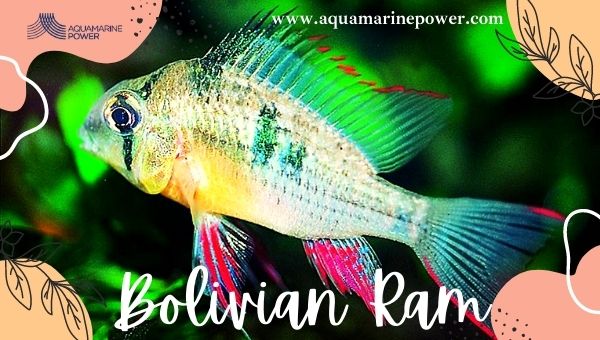
- Scientific Name: Mikrogeophagus altispinosus
- Size: 3-4 inches
- pH of water: 7.0-8.0
- Lifespan: 5 years or longer if properly cared for
- Temperament: Peaceful, schooling fish that works well with other tank mates
- Water Temperature: 78-82 degrees Fahrenheit
- Water Type: Soft to the slightly hard water with neutral pH levels.
- Minimum Tank Size: 30 gallons or larger since this is a shoaling fish, and they get very active throughout the day. They’re much happier when they have plenty of room to swim around.
Other requirements: The minimum tank size should be 50 gallons or larger since Bolivian Rams are extremely active and need more space than other species.
Bolivian rams are some of the most playful freshwater fish available because they’re always on the go. These fish were initially known as “Ram cichlids” but changed their name to reflect the fact that they’re not related to carp fish.
Bolivian rams are schooling fish, so they need plenty of their own kind to feel comfortable, and you’ll have much happier fish if you have the chance to keep them in a larger group.
They’re best kept with 3 or more of their own kind, but tanks with a minimum size of 30 gallons will make it a lot easier to accommodate them.
Bolivian rams prefer soft and slightly hard water, and they can live in both freshwater and slightly brackish water. They can adapt to a wide range of water conditions, but they’ll be most comfortable in warmer tank temperatures between 78-82 degrees Fahrenheit.
These fish are primarily herbivores who feed on algae and plant matter, so they should be fed at least twice daily with plant matter or algae wafers. They also like frozen brine shrimp and tubifex worms but prefer their food to be high in fiber.
Bolivian rams are carnivores but should only be fed high-quality flake or pellet food daily to ensure optimum health.
Bolivian rams can be housed in tanks that are 5 gallons or larger, but the bigger the tank is, the better. They do best if they’re kept in a small group of 3-4 so they can keep each other entertained and active throughout the day.
11. Neon Blue Rasbora
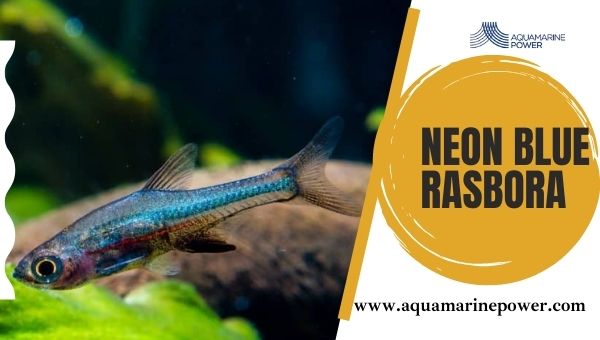
- Scientific Name: Sundadanio axelrodi
- Size: 2-3 inches
- pH of water: 6.5-7.0
- Lifespan: 5 years or longer if properly cared for
- Temperament: Peaceful, schooling fish that works well with other tank mates
- Water Temperature: 68-82 degrees Fahrenheit
- Water Type: Soft to the slightly hard water with neutral pH levels.
- Minimum Tank Size: 10 gallons is recommended for new fish owners and people who want to keep a small group of Tetras
- Other requirements: The minimum tank size should be 30 gallons or larger, and these fish will not do well in overly warm water.
Neon blue rasboras are some of the most peaceful freshwater fish available because they get along with other species very well. These fish were primarily known as “Harlequin rasbora” but changed their name to reflect the fact that they’re not related to carp fish.
Neon blue rasboras are schooling fish, so they need plenty of their own kind to feel comfortable, and you’ll have much happier fish if you have the chance to keep them in a larger group.
They’re best kept with 6 or more of their own kind, but tanks with a minimum size of 10 gallons will make it a lot easier to accommodate them.
Neon blue rasbora prefers soft and slightly hard water, and they can live in both freshwater and slightly brackish water. They can adapt to a wide range of water conditions, but they’ll be most comfortable in warmer tank temperatures between 68-82 degrees Fahrenheit.
These fish are primarily herbivores who feed on algae and plant matter, so they should be fed at least twice daily with plant matter or algae wafers. They also like frozen brine shrimp and tubifex worms but prefer their food to be high in fiber.
Neon blue rasboras are carnivores but should only be fed high-quality flake or pellet food daily to ensure optimum health.
Neon blue rasboras can be housed in tanks that are 10 gallons or larger, but the bigger the tank is, the better. They do best if they’re kept in a small group of 6 or more so they can keep each other entertained and active throughout the day. They’re not related to carp fish.
Some of the most peaceful freshwater fish available because they get along with other species very well. These fish were primarily known as “Green Cloud Mountain.
12. Pygmy Corydoras
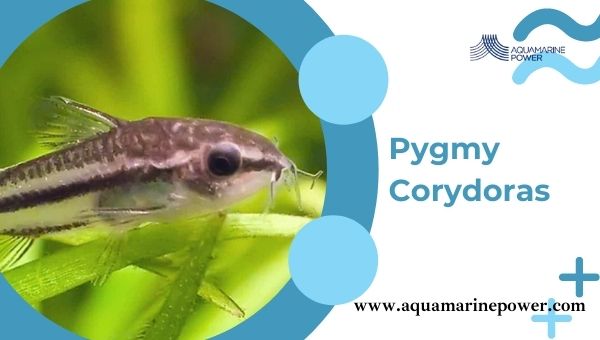
- Scientific Name: Brochis splendens
- Size: 1-2 inches
- pH of water: 6.5-7.0
- Lifespan: 5 years or longer if properly cared for
- Temperament: Peaceful, schooling fish that works well with other tank mates
- Water Temperature: 68-82 degrees Fahrenheit
- Water Type: Soft to the slightly hard water with neutral pH levels.
- Minimum Tank Size: 20 gallons or larger since the minimum tank size should be 30 gallons or larger, and these fish will not do well in overly warm water.
- Other requirements: The minimum tank size should be 30 gallons or larger, and these fish will not do well in overly warm water.
Pygmy corydoras are some of the most peaceful freshwater fish available because they get along with other species very well. These fish were primarily known as “Panda Cory” but changed their name to reflect the fact that they’re not related to carp fish.
Pygmy corydoras are schooling fish, so they need plenty of their own kind to feel comfortable, and you’ll have much happier fish if you have the chance to keep them in a larger group.
They’re best kept with 6 or more of their own kind, but tanks with a minimum size of 20 gallons will make it a lot easier to accommodate them.
Pygmy corydoras prefer soft and slightly hard water, and they can live in both freshwater and slightly brackish water. They can adapt to a wide range of water conditions, but they’ll be most comfortable in warmer tank temperatures between 68-82 degrees Fahrenheit.
These fish are primarily herbivores who feed on algae and plant matter, so they should be fed at least twice daily with plant matter or algae wafers. They also like frozen brine shrimp and tubifex worms but prefer their food to be high in fiber.
Pygmy corydoras are omnivores but should only be fed high-quality flake or pellet food daily to ensure optimum health.
Pygmy corydoras can be housed in tanks that are 10 gallons or larger, but the bigger the tank is, the better. They do best if they’re kept in groups of 5 or more so they can keep each other entertained and active throughout the day.
Also Read: The Best 15 Types Of Plecos For Your Tank
13. Dwarf Gourami
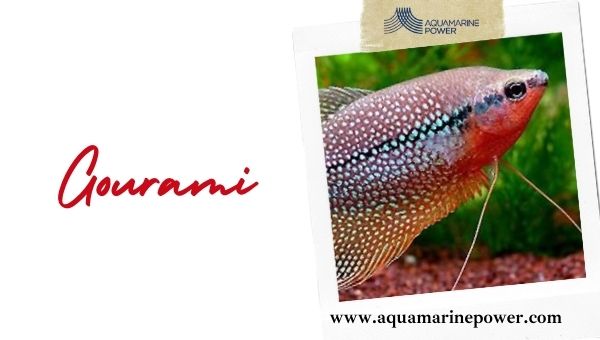
- Scientific Name: Colisa lalia
- Size: 2-3 inches
- pH of water: 6.5-7.0
- Lifespan: 5 years or longer if properly cared for
- Temperament: Peaceful, schooling fish that works well with other tank mates
- Water Temperature: 68-82 degrees Fahrenheit
- Water Type: Soft to the slightly hard water with neutral pH levels.
- Minimum Tank Size: 10 gallons is recommended for new fish owners and people who want to keep a small group of Tetras
- Other requirements: The minimum tank size should be 30 gallons or larger
Colisa lalia is some of the most peaceful freshwater fish available because they get along with other species very well. These fish were primarily known as “Betta” but changed their name to reflect the fact that they’re not related to carp fish.
Colisa lalia is an omnivore but should only be fed high-quality flake or pellet food daily to ensure optimum health. They do best if they’re kept in groups of 5 or more so they can keep each other entertained and active throughout the day.
Their preference is for staying near the bottom of the tank, where they like to rest among the roots and leaves of plants. They’ll usually float near the top during feeding time, and they can even jump out of the tank if it isn’t covered well enough.
These fish prefer to be kept in water that is soft and slightly hard with neutral pH levels and a temperature between 68-82 degrees Fahrenheit.
Keep these fish in groups of 2, or more so they have friends to play with, but it isn’t necessary because they’re not as outgoing as other fish.
Colisa lalia can be housed in tanks that are 10 gallons or larger, but the bigger the tank is, the better. They do best if they’re kept in groups of 5 or more so they can keep each other entertained and active throughout the day.
14. White Cloud Mountain Minnow
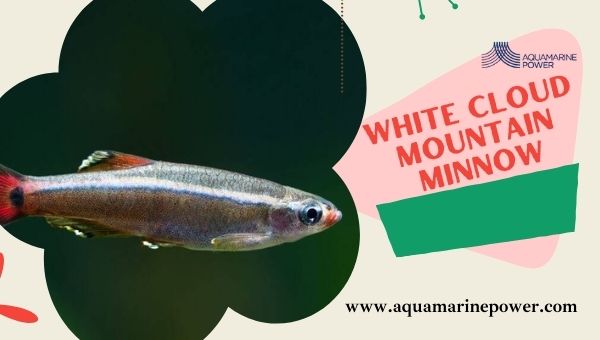
- Scientific Name: Tanichthys albonubes
- Size: 2-3 inches
- pH of water: 6.5-7.0
- Lifespan: 5 years or longer if properly cared for
- Temperament: Peaceful, schooling fish that works well with other tank mates
- Water Temperature: 68-82 degrees Fahrenheit
- Water Type: Soft to the slightly hard water with neutral pH levels.
- Minimum Tank Size: 10 gallons is recommended for new fish owners and people who want to keep a small group of Tetras
- Other requirements: The minimum tank size should be 30 gallons or larger, and these fish will not do well in overly warm water.
Tanichthys albonubes are some of the most peaceful freshwater fish available because they get along with other species very well. These fish were primarily known as “Betta” but changed their name to reflect the fact that they’re not related to carp fish.
Tanichthys albonubes are omnivores but should only be fed high-quality flake or pellet food daily to ensure optimum health.
These fish prefer to be kept in water that is soft and slightly hard with neutral pH levels and a temperature between 68-82 degrees Fahrenheit. They do best if they’re kept in groups of 5 or more so they can keep each other entertained and active throughout the day.
Tanichthys albonubes are some of the most peaceful freshwater fish available because they get along with other species very well. These fish were primarily known as “Green Cloud Mountain Minnow” but changed their name to reflect the fact that they’re not related to carp fish.
Tanichthys albonubes are omnivores but should only be fed high-quality flake or pellet food daily to ensure optimum health. These fish prefer to be kept in water that is soft and slightly hard with neutral pH levels and a temperature between 68-82 degrees Fahrenheit.
Tanichthys albonubes can be housed in tanks that are 10 gallons or larger, but the bigger the tank is, the better. They do best if they’re kept in groups of 5 or more so they can keep each other entertained and active throughout the day.
15. Killifish
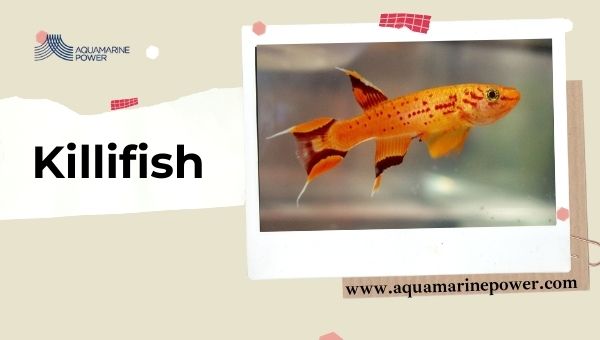
- Scientific Name: Aphyosemion spp.
- Size: 1-2 inches
- pH of water: 7-7.5
- Lifespan: 5 years or longer if properly cared for
- Temperament: Peaceful, schooling fish that works well with other tank mates
- Water Temperature: 68-82 degrees Fahrenheit
- Water Type: Soft to the slightly hard water with neutral pH levels.
- Minimum Tank Size: 10 gallons is recommended for new fish owners and people who want to keep a small group of Tetras
- Other requirements: The minimum tank size should be 30 gallons or larger, and these fish will not do well in overly warm water.
Aphyosemion spp. is one of the most peaceful freshwater fish available because they get along with other species very well. These fish were primarily known as “Killies” but changed their name to reflect the fact that they’re not related to carp fish.
Aphyosemion spp. is an omnivore but should only be fed a high-quality flake or pellet food daily to ensure optimum health.
These fish prefer to be kept in water that is soft and slightly hard with neutral pH levels and a temperature between 68-82 degrees Fahrenheit. They do best if they’re kept in groups of 5 or more so they can keep each other entertained and active throughout the day.
Aphyosemion spp. is one of the most peaceful freshwater fish available because they get along with other species very well. These fish were primarily known as “Killies” but changed their name to reflect the fact that they’re not related to carp fish. Aphyosemion spp. is an omnivore but should only be fed a high-quality flake or pellet food daily to ensure optimum health.
Water temperature is the most important factor in keeping these freshwater fish alive and healthy, so make sure their tank has an ideal temperature between 68-82 degrees Fahrenheit.
Aphyosemion spp. do best if they’re kept in groups of 5 or more so they can keep each other entertained and active throughout the day, but these fish will do fine if kept alone as long as their housing is adequate for one Aphyosemion spp, per 10 gallons of water.
Aphyosemion can be housed in tanks that are 10 gallons or larger, but the bigger the tank is, the better. They do best if they’re kept in groups of 5 or more so they can keep each other entertained and active throughout the day.
16. Pencilfish
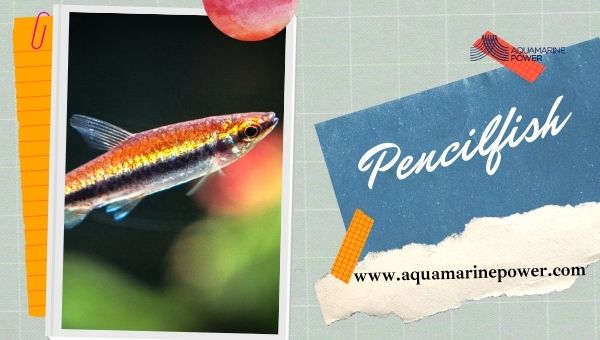
- Scientific Name: Nannostomus spp.
- Size: 1-2 inches
- pH of water: 6.5-7.0
- Lifespan: 5 years or longer if properly cared for
- Temperament: Peaceful, schooling fish that works well with other tank mates
- Water Temperature: 68-82 degrees Fahrenheit
- Water Type: Soft to the slightly hard water with neutral pH levels.
- Minimum Tank Size: 10 gallons is recommended for new fish owners and people who want to keep a small group of Tetras
- Other requirements: The minimum tank size should be 30 gallons or larger, and these fish will not do well in overly warm water.
Nannostomus spp. is one of the most peaceful freshwater fish available because they get along with other species very well. These fish were primarily known as “Pencilfish” but changed their name to reflect the fact that they’re not related to carp fish.
Nannostomus spp. are primarily omnivores but should only be fed high-quality flake or pellet food daily to ensure optimum health. These fish prefer to be kept in water that is soft and slightly hard with neutral pH levels and a temperature between 68-82 degrees Fahrenheit.
They do best if they’re kept in groups of 5 or more so they can keep each other entertained and active throughout the day. These fish should only be fed high-quality flake or pellet food daily to ensure optimum health. Do best if they’re kept in groups of 5 or more.
They do best if they’re kept in tanks that are 10 gallons or larger, but the bigger the tank is, the better. They do best if they’re kept in water that is soft and slightly hard with neutral pH levels. Their ideal temperature range is between 68-82 degrees Fahrenheit.
Nannostomus are omnivores but should only be fed high-quality flake or pellet food daily to ensure optimum health.
Nannostomus can be housed in tanks that are 10 gallons or larger, but the bigger the tank is, the better. They do best if they’re kept in groups of 5 or more so they can keep each other entertained and active throughout the day.
17. Rasbora
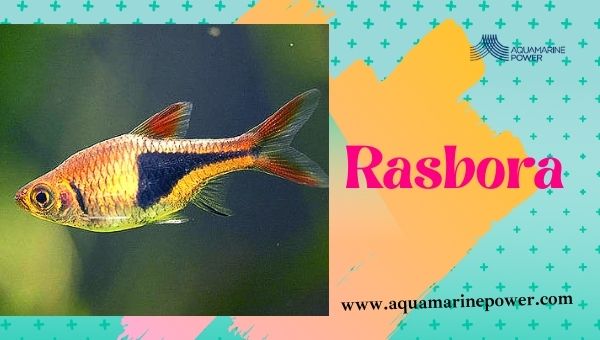
- Scientific Name: Danio spp.
- Size: 1-2 inches
- pH of water: 6.5-7.0
- Lifespan: 5 years or longer if properly cared for
- Temperament: Peaceful, schooling fish that works well with other tank mates
- Water Temperature: 68-82 degrees Fahrenheit
- Water Type: Soft to the slightly hard water with neutral pH levels.
- Minimum Tank Size: 10 gallons is recommended for new fish owners and people who want to keep a small group of Tetras
- Other requirements: The minimum tank size should be 30 gallons or larger, and these fish will not do well in overly warm water.
Danio spp. are some of the most peaceful freshwater fish available because they get along with other species very well. These fish were primarily known as “Rasbora” but changed their name to reflect the fact that they’re not related to carp fish.
Danio spp. are primarily omnivores but should only be fed high-quality flake or pellet food daily to ensure optimum health.
These fish prefer to be kept in water that is soft and slightly hard with neutral pH levels and a temperature between 68-82 degrees Fahrenheit. They do best if they’re kept in groups of 5 or more so they can keep each other entertained and active throughout the day.
Danio spp. Do best if they’re kept in tanks that are 10 gallons or larger, but the bigger the tank is, the better. They do best if they’re kept in water that is soft and slightly hard with neutral pH levels. Their ideal temperature range is between 68-82 degrees Fahrenheit. They do best if they’re kept in groups of 5 or more so they can keep each other entertained and active throughout the day.
18. Tetra
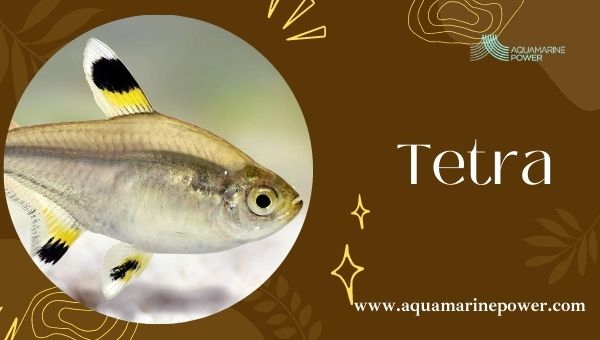
- Scientific Name: Pristella maxillaris
- Size: 1-2 inches
- pH of water: 6.5-7.0
- Lifespan: 5 years or longer if properly cared for
- Temperament: Peaceful, schooling fish that works well with other tank mates
- Water Temperature: 68-82 degrees Fahrenheit
- Water Type: Soft to the slightly hard water with neutral pH levels.
- Minimum Tank Size: 10 gallons is recommended for new fish owners and people who want to keep a small group of Tetras
- Other requirements: The minimum tank size should be 30 gallons or larger, and these fish will not do well in overly warm water.
Pristella maxillaris are some of the most peaceful freshwater fish available because they get along with other species very well. These fish were primarily known as “Tetra” or Ruby Tetra or other tetra but changed their name to reflect the fact that they’re not related to carp fish.
These fish prefer to be kept in water that is soft and slightly hard with neutral pH levels and a temperature between 68-82 degrees Fahrenheit. They do best if they’re kept in groups of 5 or more so they can keep each other entertained and active throughout the day.
Pristella maxillaris do best if they’re kept in tanks that are 10 gallons or larger, but the bigger the tank is, the better. They do best if they’re kept in water that is soft and slightly hard with neutral pH levels.
Pristella maxillaris are omnivores but should only be fed high-quality flake or pellet food daily to ensure optimum health. These fish prefer to be kept in water that is soft and slightly hard with neutral pH levels and a temperature between 68-82 degrees Fahrenheit.
They do best if they’re kept in groups of 5 or more so they can keep each other entertained and active throughout the day.
19. Ram (Mikrogeophagus ramirezi)
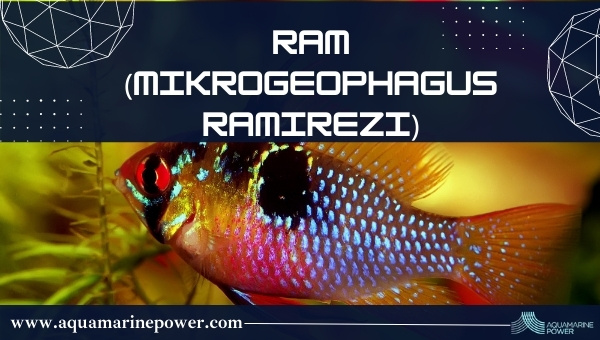
- Scientific Name: Microgeophagus ramirezi
- Size: 2-3 inches
- pH of water: 6.5-7.0
- Lifespan: 5 years or longer if properly cared for
- Temperament: Peaceful, schooling fish that works well with other tank mates
- Water Temperature: 68-82 degrees Fahrenheit
- Water Type: Soft to the slightly hard water with neutral pH levels.
- Minimum Tank Size: 10 gallons is recommended for new fish owners and people who want to keep a small group of Tetras
- Other requirements: The minimum tank size should be 30 gallons or larger, and these fish will not do well in overly warm water.
Ram cichlids are some of the most peaceful freshwater fish available because they get along with other species very well. These fish were primarily known as “Pike Cichlid” but changed their name to reflect the fact that they’re not related to carp fish.
Ram cichlids are schooling fish, so they need plenty of their own kind to feel comfortable, and you’ll have much happier fish if you have the chance to keep them in a larger group. They’re best kept with 6 or more of their own kind, but tanks with a minimum size of 10 gallons will make it a lot easier to accommodate them.
Ram cichlids prefer soft and slightly hard water, and they can live in both freshwater and slightly brackish water. They can adapt to a wide range of water conditions, but they’ll be most comfortable in warmer tank temperatures between 68-82 degrees Fahrenheit.
These fish are primarily herbivores who feed on algae and plant matter, so they should be fed at least twice daily with plant matter or algae wafers. They also like frozen brine shrimp and tubifex worms but prefer their food to be high in fiber.
Ram cichlids can be housed in tanks that are 10 gallons or larger, but the bigger the tank is, the better. They do best if they’re kept in groups of 5 or more so they can keep each other entertained and active throughout the day.
Related: Best Ruby Tetra Guide: Explained in Details
Conclusion
These are 19 small freshwater fishes that can go into a nano tank. They will need specific cycling if you want to stock them. Make sure you research the needs of each fish before deciding. Keep in mind their compatibility with your other fish.
These are compatible with snails and shrimp. Add some driftwood or bogwood for them to nibble on. They are also compatible with live plants if you want to decorate your tank. Keep in mind that during the night, they might try to snack on them.
They Will do great at a pH between 6 and 8, soft water with 1-15 dGH but should not be introduced into an aquarium that already has fish. These are just basic conditions to keep in mind. Research the species you want to keep so you know what exact water condition they need.
These are best kept in small groups (6 or more) for the best coloration. They do well in tanks with lots of plants like an Amazon biotope aquarium but make sure there are some floating plants to provide cover and security.
They will eat pretty much anything, including live plants and aquarium invertebrates, so it’s best kept alone in a heavily planted tank.
These are small freshwater fishes that can be put into a nano tank. It will need specific cycling if you want to stock them. Make sure you research the needs of each fish before deciding. Keep in mind their compatibility with your other fish.




